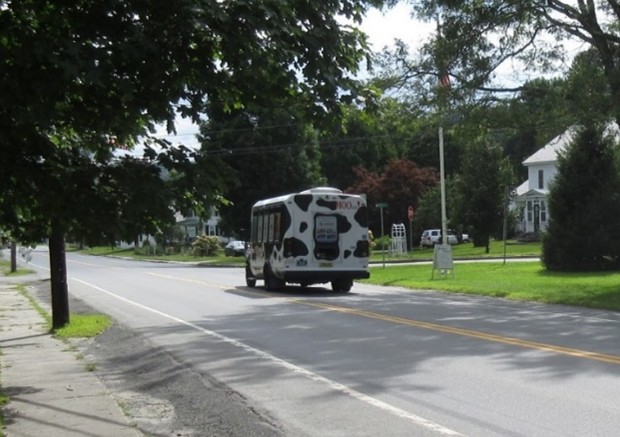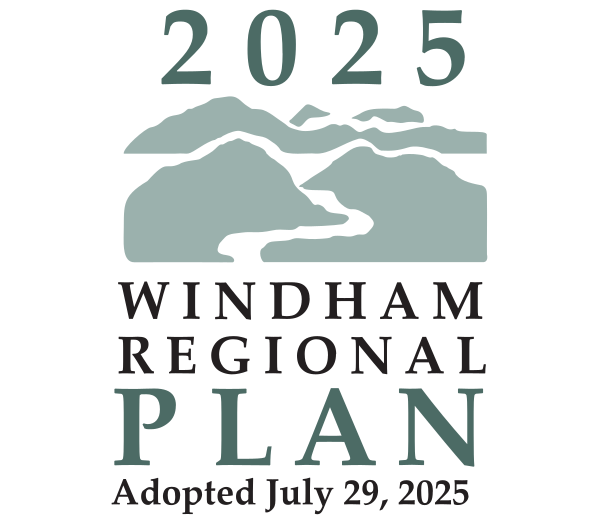Transportation
Transit
Public transportation is a critical component of meeting the overall transportation needs and climate goals of the Windham Region. Adequate bus and rail service are a vital piece of our overall transportation system, providing needed transportation for those without access to a personal vehicle and reducing dependence on personal vehicle trips. This is an important piece of transportation equity in our region, providing vulnerable transit dependent populations such as the elderly, people with disabilities, and low-income residents needed access to education, employment, health care and all other manner of daily needs. This in turn strengthens the overall vitality of the region.
Bus Service

Photo Credit: WRC
Transit service in the Windham Region is provided primarily by Southeast Vermont Transit, widely known as the MOOver. Southeast Vermont Transit was formed from the merger of Deerfield Valley and Connecticut River Transit in 2015. Easily recognizable by their black and white cow patterned vehicles, the MOOver provides bus service throughout most of the region. Currently, fixed route service is available between Readsboro and Dover by way of Wilmington and Whitingham in the Deerfield Valley, between Brattleboro and Bellows Falls in the Connecticut River Valley, and along the Route 9 corridor between Brattleboro and Bennington with a connection in Wilmington. In town service exists in both Bellows Falls and Brattleboro, including connections from Brattleboro to Guilford and Hinsdale, NH, and from Bellows Falls to Springfield, White River Junction, and Dartmouth-Hitchcock Hospital. Furthermore, a pilot program running seasonal winter buses from Stratton Mountain to Manchester Center has recently been made permanent.
Despite the overall success of the MOOver transit service, there still exist unmet transportation needs in the region and the Windham Regional Commission is supportive of continued efforts to expand transit both within the region and to neighboring regions. Fixed route bus service has historically been the primary mode of public transportation service in the region and across Vermont. However, the limitations of fixed route bus service to effectively and efficiently meet the transportation needs of the public are increasingly being recognized and expanding access to alternative modes of transit is an important part of improving the overall transportation landscape.
Substantial portions of the region remain underserved by public transportation, particularly rural towns outside of the Connecticut and Deerfield River Valleys. The WRC supports the expansion of SEVT service wherever possible, however it also recognizes the need for alternative options to fully meet the transportation needs of the region. Local non-profit organizations have begun to help fill this gap in our region, organizations like the various local ‘Cares’ groups providing some transportation service to underserved communities.
NEIGHBORHOOD CONNECTIONS ON-DEMAND TRANSPORTATION SERVICE
Neighborhood Connections is a social services organization based in Londonderry in the northwest corner of the Windham Region. Neighborhood Connections recognized the severe impact a lack of transit options had on overall health and vitality for residents of underserved towns along the spine of the Green Mountains. In 2020, Neighborhood Connections launched the Mountain Town Connector, a door to door transit service providing on demand transportation to five towns in the northwest corner of the region. The Mountain Town Connector provides a successful model for other organizations to emulate to meet unmet transportation needs in the Windham Region.
The expansion of micro transit service is another alternative. Micro transit is smaller scale transportation that provides On-Demand, Door-Door to service to riders. Passengers can request a ride, either over the phone or using a smartphone application, and be picked up, sometimes within minutes of having requested a ride, and dropped off directly at their requested destination. Improvements in technology have greatly increased the feasibility of such on-demand services, allowing riders to request a ride and be routed efficiently to their destination using software that identifies available drivers based on other currently scheduled riders. Micro transit service provides a more efficient, convenient, and cost-effective transportation option for riders than traditional fixed route service. Furthermore, the efficiencies made possible by micro transit allow for more effective use of fixed route service over distances where micro transit service is not feasible, improving the transit network as a whole.
As of 2024, the Vermont Agency of Transportation has invested in seven micro transit pilot programs across Vermont, including a service operated by Southeast Vermont transit just north of our region in Windsor. Ridership in the Windsor pilot program has greatly exceeded projections, and the expectation is that similar service will be expanded across Vermont in the coming years. Brattleboro and Rockingham are strong candidates for the expansion micro transit programs.
Interstate transit connections remain a significant gap in the overall transportation network of the Windham Region, most notably the lack of regular service between Brattleboro and the nearby cities of Greenfield, Massachusetts and Keene, New Hampshire. Our location at the corner of three states puts the Windham Region in a unique position within Vermont, and many people travel across state lines each day for employment, education, and healthcare. Greenfield and Keene are the largest out of state destinations for residents of the Windham Region, as well as the most important points of origin for commuters into our region. No bus service currently exists between Brattleboro, Keene, and Greenfield. A 2022 study commissioned by the Southwest New Hampshire Regional Planning Commission, the Windham Regional Commission’s counterpart across the river in Cheshire County, NH, examined the possibility of a future fixed route service connecting Brattleboro and Keene, and received significant public support.
Passenger Rail Service
In addition to bus service, passenger rail is a critical piece of the transportation landscape of the Region. Currently, the only passenger rail service in the Windham Region is the Amtrak Vermonter line, running once daily each way with stops in both Brattleboro and Bellows Falls, with service north to White River Junction, Montpelier-Berlin, and Essex Junction, as well as south to Greenfield, Northampton, and Springfield, Massachusetts, before continuing onward into Connecticut and New York City. The Vermonter is an important link between our region and popular destinations within Vermont and neighboring states, increasing regional mobility for residents and visitors alike. Passenger rail is an important piece of overall mobility and economic development in the Region, providing a direct connection to our region for potential visitors from nearby major metropolitan areas as well as expanding access to economic opportunities for residents. With the rise of hybrid-remote work schedules in the wake of the Covid-19 pandemic, the importance of these connections has increased and expanding passenger rail service in the region is an important goal of this plan.
Data from Amtrak demonstrates the success of passenger rail in the Windham Region, with ridership in Brattleboro being above average in the larger context of the Vermonter corridor. Ridership data from 2022 counted 14,258 trips originating in Brattleboro, the 2nd most of any station in Vermont behind only Essex Junction, and the 4th most on the entire Vermonter line, far exceeding the number of riders in much larger cities such as Hartford, Connecticut and Springfield, Massachusetts. The New York City-Brattleboro connection rated as the 2nd busiest on the entire line, second only to the NYC-Northampton connection. The success of the Vermonter train in Brattleboro despite the significant limitation of only one daily trip in each direction points to an unmet passenger rail need in Southeastern Vermont.
There are several initiatives to expand passenger rail service within Vermont and the larger New England region. In December of 2023, the Federal Rail Administration announced three planning grants to examine expanded passenger rail in Vermont. This includes a study for expanded service on the Vermonter line, including increased trip frequencies between New York City and White River Junction with up to four daily round trips at both Brattleboro and Bellows Falls, reduced travel time with the goal of saving 90 minutes between Essex Junction and Springfield, Massachusetts, and the extension of the service north to Montreal. This is a major development for passenger rail in our region and would greatly improve the viability of rail as a local and regional commuting option for residents. Increased potential for local ridership would reduce passenger vehicle trips and allow for greater efficiencies for our regional bus system, improving mobility, expanding regional housing and employment options, and helping the Windham Region achieve its energy goals.
Also relevant to our region are ongoing passenger rail initiatives in neighboring Western Massachusetts, officially known as the ‘Compass Rail Plan’. After several years of study, the Massachusetts Department of Transportation has received funding to begin construction in 2027 of an East-West passenger rail connection between Boston and the Albany, New York through Western Massachusetts. This service will provide up to ten daily round trips between Boston and Albany, with stops in Worcester, Springfield and Pittsfield. Together with expanded north-south service within the Connecticut River Valley, Compass Rail will provide a passenger rail connection between the Windham Region and Boston, the Berkshires, and Upstate New York.
In addition to the Compass Rail Plan, the ongoing Massachusetts ‘Northern Tier Rail Study’ has the potential to provide an even more direct connection to Boston for the Windham Region. This initiative is examining East-West rail service in the northern part of Massachusetts along the Massachusetts Route 2 Corridor, exploring potential for new passenger rail service between Boston, Greenfield, and North Adams. Given the close proximity of Greenfield, this line would provide the most direct passenger rail connection between Boston and the Windham Region.
The Windham Regional Commission strongly supports these ongoing rail initiatives. Expanding passenger rail service is an important piece of improving mobility, promoting economic development and enhancing overall quality of life for the Windham Region.
